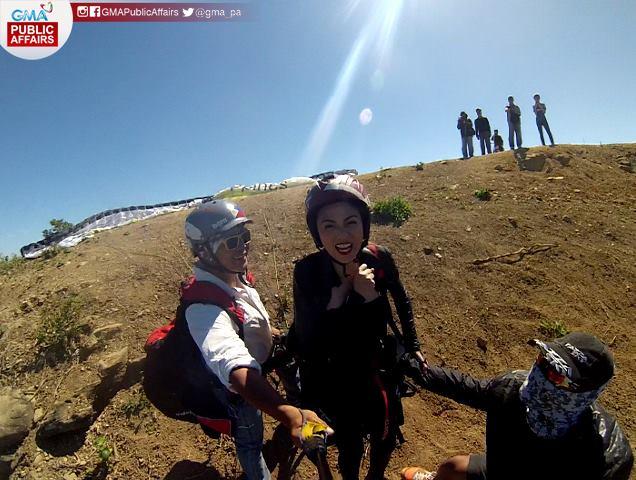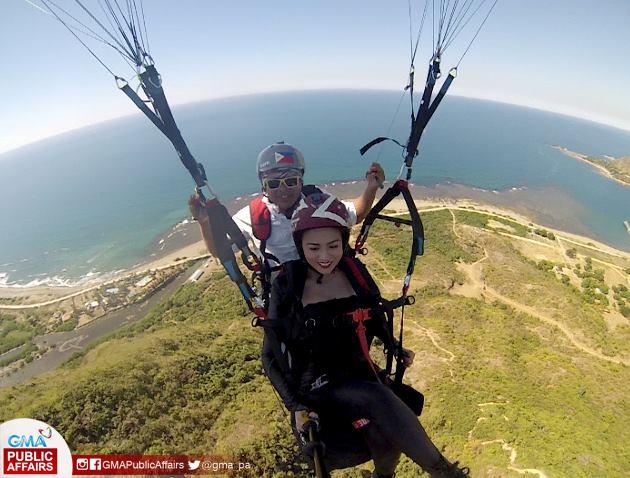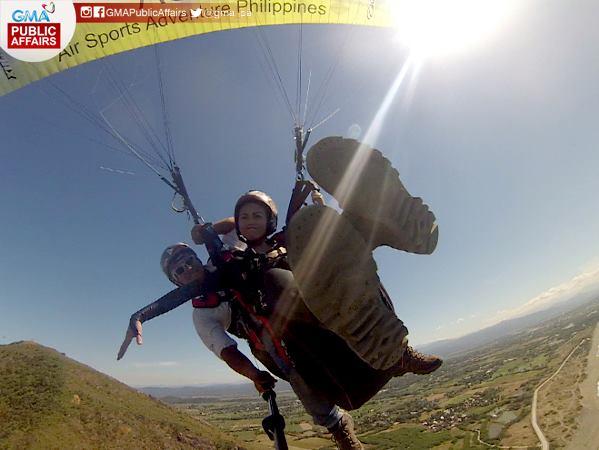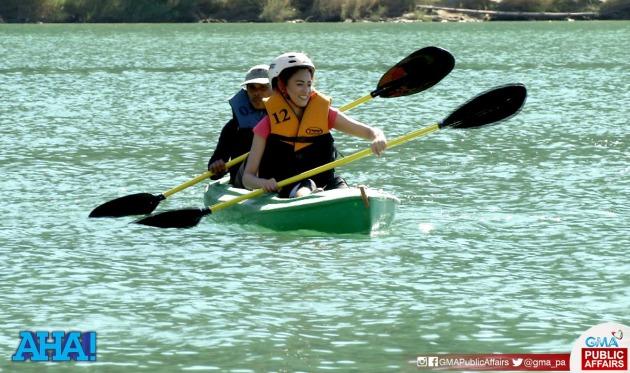Hop, climb, and fly: The many things to do and learn in Ilocos Sur
_2016_02_29_16_01_39.jpg)
When a person hears “Ilocos Sur,” what probably comes to his mind are the cobblestone streets in Vigan City, or the clay pots and the abel, or the longganisa and bagnet that the region takes pride of. There’s nothing wrong with that. After all, Vigan City in particular was named as one of the New7Wonder Cities of the World in 2014 because of its well-preserved historical aesthetics.
But “AHA!” arrived in the province not for some history talks but rather for some information and thrill-seeking. How do paragliders manage to stay up in the sky? Where do thermals come from, and how do they create a lift that supports paragliders? Why do kangaroos hop? Is it true that kangaroos run faster than a racehorse? Why is it that you can only use via ferrata climb in ascending and not in descending?
Thankfully, aside from having famous heritage villages and bagnet, Ilocos, too, has the right places for new discoveries and exciting escapades.
Fly like a bird
One of the first things that “AHA!” discovered in Ilocos Sur is that flying is now possible!
Well, sort of.
Paragliding is an air sports that’s made possible through a wing that basically carries the paraglider up in the air (yup, like flying!). There are 30 lines that are connected from the wing that supports the weight of the paraglider. There is also a harness that serves as the seat of the paraglider while flying.

However, paragliding is oftentimes called as “para-waiting,” an inside joke among air sports enthusiasts, because the paragliders have to wait before the wind becomes friendly for some flying adventures. The wind speed, according to the air sports specialists who assisted the “AHA!” squad in this exciting air sports, is commonly unpredictable.

As the wind goes horizontally, it bounces through the mountain or the hill upwards, which lifts the paragliders up. This is also supported by the thermals that come from lands such as rice fields or pavement roads.

It’s only advisable to fly if the wind is within 10 to 20/kph. If it’s lower, the paraglider won’t enjoy the paragliding experience as he’ll probably be up in the air for less than five minutes only (#bitin!). And if the wind is too strong, it would be easy for the paraglider to get out of control.
"Ang paragliding, kailangan niya ng bundok o kailangan niya ng source ng lift. So hindi kailangan na sobrang taas na bundok. Puwede naman kahit 10ft o 15ft [from the ground ang take-off point], puwede ka nang umangat sa lupa, puwede mo nang mamaneho ‘yung sarili mo pabalik-balik,” says air sports specialist Randell Buko Raymundo of Air Sports Adventure Philippines (ASAP).

In Narvacan, Ilocos Sur, paragliders go atop the Bantay Abot Hill in Narvacan Outdoor Adventure Hub, which is 1,050 feet from the ground. This is only their take-off point; when the “AHA!” team and ASAP flew up, they managed to reach 1,700 feet from the ground! Wow! You can only just imagine the fantastic view of the hills, rice fields, and the turquoise sea water that this province boasts of from up there in the sky!
Here in the Philippines, you can experience paragliding in some places that are popular for air sports such as Carmona, Cavite; Maasim, Saranggani Province; and Daet, Camarines Norte. Although you got to undergo some “para-waiting” (learn the air sports terms starting now!), it’s just all part of the experience. As the “AHA!” squad realized upon landing, the para-waiting part is nothing compared to the 15 minutes of breathtaking paragliding experience
Hop and play with the kangaroos
Another thing that “AHA!” learned in Ilocos Sur is that Baluarte Ni Chavit in Vigan now houses the country’s first kangaroos, two of which are female and three are male. The kangaroos first arrived in the Philippines on January 14, 2016, imported from Dallas, Texas, USA. But because they’re still young, they’re now under quarantine to avoid exposing them to stress.
_2016_02_29_16_02_04.jpg)

The kangaroo is the only large mammal that uses hopping as its main mode of locomotion because they can reach farther point when they hop. Speed-wise, this animal barely gets left behind. In fact, it can go as fast as 65/kph--which is faster than a racehorse! The kangaroo can also jump as high as three meters or half of the height of an average adult giraffe.
But be careful when you’re near them! Because of their incredible leg power, their kick can be dangerous sometimes. That’s why in the famous arcade game Tekken, kangaroos Roger and his son Roger, Jr. are both known for their strong kicks that can topple their opponents down. Hiyaaah!
The kangaroos that are now housed at Baluarte Ni Chavit are Red Kangaroos. This particular breed is the largest surviving marsupial in the world and has the most number of animals that carry their young in their pouch. The other types of kangaroo are Eastern Gray Kangaroo, Western Gray Kangaroo, and Antilopine Kangaroo. They differ mostly in origin and color and texture of fur. AHA!

When you visit the kangaroos at Baluarte Ni Chavit, the zookeepers could allow you to mingle with them if current conditions would allow. Guest host Arianne Bautista got to feed one of the kangaroos, “Tintin,” provided that the joey would be in a bag. This technique is done when feeding the joeys to provide them almost the same experience when they’re in their mother’s pouch. Cute!
Brave the via ferrata climb
Via ferrata is another interesting activity that the “AHA!” team discovered in Ilocos Sur. With paragliding, via ferrata, and the other thrilling outdoor adventures like zipline and kayaking that “AHA!” got to learn about and try in Ilocos Sur, the Ilocanos must have a thirst for anything extreme, huh?

In hiking the via ferrata, there’s a harness around your body that’s connected to the steel cable that goes from the base of the hill all the way to the summit. This, of course, ensures that you won’t fall off, making via ferrata an outdoor adventure that can be done by the whole family.

Via ferrata started during the World War I in the 19th century. Via ferrata routes were created in the Dolomite Mountain Region in Italy to support the troops in moving from one place to another. Since then, via ferrata routes started sprouting across the world because of its tourism benefits. Currently, there are around 1,000 via ferrata routes in the world, most of which can be found in the Alps that’s situated in Italy and Austria.
Typically, via ferrata is only used in ascending the hill or the mountain because it’s hard to descend through this activity. So via ferrata routes in different countries have their different ways of descending.
_2016_02_29_15_55_06.jpg)
In the route found in Narvacan Outdoor Adventure Hub in Narvacan, Ilocos Sur, those who finish ascending the via ferrata can descend by means of zipline! “Ito ‘yung parang premyo mo after mong umakyat ng pagkahirap-hirap sa mga bato,” says Arianne. “‘Pag narating mo na ang tuktok, lilipad ka na!” Woohooooo!

True: Ilocos Sur is known around the world because of its conservation efforts. But also true: Ilocos Sur is now starting to become a place not just for conserving the past, but for also exploring its natural promises for some new discoveries and thrilling activities.---BMS/GMA Public Affairs




